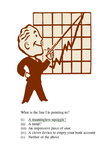Are you suggesting I'm water in the desert or a damp patch?
More seriously, although I'm terribly fond of metaphor myself, those generally used for trading tend to indicate an excessively difficult task and therefore the metaphors are positioned at this Quest-type level. Is this a function of the reality of trading or the expectation of the reality of trading?
A bar or any time period is a metaphor for the reality.
I fell into exactly that same trap of metaphors with Searchlight. We’re using weather rather than water in the desert in his examples. You get a nice warm feeling with metaphors, quite rightly, as they allow comfort in subjective interpretation of that to which is being alluded. You can never get a metaphor wrong.
But if we’re going to talk about weather, specifically rather than as a metaphor for trading, if I want to know what the weather is doing right now (tick) – I look out the window. If I’m going somewhere else and I want to know what the weather is now, I phone ahead and ask. If I’m going to be somewhere else in a time displaced significantly from now, I take umbrella, shorts, coat, sunscreen, beach ball, skis and survival pack.
To suggest different TFs for different purposes is to confuse what I’m doing here. My part 1 post on this made clear that all the things you normally hold dear, such as SR in higher TFs, trend, channels etc, all our old friends are still there. I asked two questions: What do we gain and what do we lose? Already folk are scrambling to hold onto what they think they’re going to lose. This is genuinely good. I really want to know these things.

